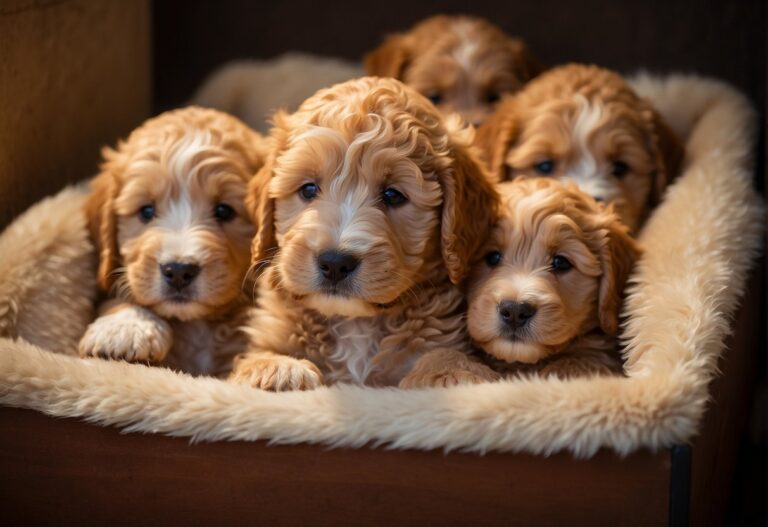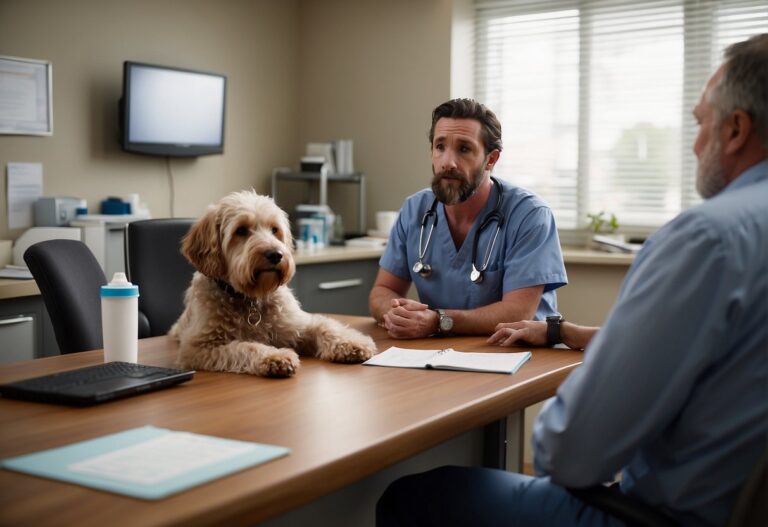Top Methods for Whelping Mini Goldendoodle Puppies Successfully

Do you want your Mini Goldendoodles to have puppies the right way? These little fluffballs are a mix of Golden Retrievers and Miniature Poodles, and they’re taking the dog world by storm. But if you’re thinking about breeding them, you’ve got to know what you’re doing.
Getting whelping Mini Goldendoodle puppies right is a big deal. It’s not just about making cute puppies – it’s about keeping the mom and her little ones safe and healthy. Mess this up, and you could be in for a world of trouble. So, let’s dive into the best ways to help your Mini Goldendoodle bring her pups into the world.
Think of this as your crash course in puppy delivery. Ready to learn the ropes?
Alright, let’s talk about getting ready for your Mini Goldendoodle’s big day. First up, you need to sort out a whelping area. Think of it as your dog’s delivery room.
Preparing for Whelping Mini Goldendoodle Puppies

Pick a spot that’s quiet and away from the hustle and bustle. Your dog needs to feel safe and cozy. A spare room or a corner of your bedroom could work. Make sure it’s warm and draft-free.
A. Setting up a whelping area
Now, for the stuff you’ll need:
- A whelping box – go for one with low sides so mum can hop in and out easily
- Lots of clean towels and blankets
- A heat lamp for the puppies
- Puppy milk replacer (just in case)
- Scissors for cutting umbilical cords
- Iodine for cleaning those cords
Got all that? Good. You’re on your way to being a top-notch doggy midwife.
B. Monitoring the pregnant Mini Goldendoodle
Keep an eye on your girl as her due date gets closer. You’ll notice her belly getting bigger, and she might start nesting – that’s when she tries to make a comfy spot for her pups.
Watch out for these signs that labour’s on the way:
- She might go off her food
- She could get restless or clingy
- Her temperature might drop below 37°C
If you spot any of these, it’s go time. Get ready to welcome some furry new arrivals!
C. Pre-whelping veterinary care
Don’t skip the vet visits when your Mini Goldendoodle is expecting. Regular check-ups are key to catching any issues early.
Your vet might suggest:
- Blood tests to check mum’s health
- X-rays to count how many puppies are on the way
- Ultrasounds to check the pups’ heartbeats
These visits are your chance to ask questions. Don’t be shy – your vet’s there to help.
Also, chat with your vet about what to do if things go wrong during whelping. It’s better to be ready for the worst and not need it, than to be caught out if something goes pear-shaped.
Remember, a healthy mum means healthy pups. So keep those vet appointments!
The Whelping Process

Let’s break down what happens when your Mini Goldendoodle starts having her puppies. It’s a bit like a three-act play, so pay attention.
Stages of Labour
Act One: Early Labour
Your dog might:
- Pant more than usual
- Pace around or dig at her bed
- Refuse food
- Vomit a bit
This can last for hours, so don’t panic. She’s just getting ready for the main event.
Act Two: Active Labour
Now we’re talking. You’ll see:
- Strong contractions
- Your dog straining
- A clear fluid from her vulva
This is when things get real. The first pup should show up within an hour of strong pushing.
Act Three: Puppy Time!
Puppies usually come every 30-60 minutes. Each pup is in its own sac. Mum should break this and lick the pup clean. If she doesn’t, you might need to step in.
Assisting Mother during Whelping
Now, about helping out. Most of the time, your job is to watch and wait. Let mum do her thing. She’s got instincts for this.
When should you jump in? If:
- Mum’s been pushing hard for over an hour with no puppy
- A puppy’s stuck halfway out
- Mum seems exhausted
How to help without getting in the way:
- Offer water between puppies
- Keep the area clean
- Help dry puppies if mum’s busy with the next one
But what if things go wrong? Keep an eye out for:
- Green or bloody discharge before the first pup
- Mum in extreme pain
- No puppies after 24 hours of labour starting
If you see any of these, call your vet right away. Don’t try to be a hero – some problems need a pro.
Keep your vet’s number handy. If you’re worried, give them a ring. It’s always better to check than to wait too long.
Remember, most Mini Goldendoodle births go smoothly. But being ready for problems means you can relax and enjoy the miracle of puppy birth. How cool is that?
Immediate Post-Whelping Care

Right, so the puppies are here. Congrats! But we’re not done yet. Let’s talk about what to do next.
Caring for the mother
First up, mum needs some TLC. Keep an eye on her for:
- Heavy bleeding (more than a period)
- Fever
- Not wanting to feed her pups
- Swollen, red, or painful teats
If you spot any of these, ring your vet. They could mean trouble.
Make sure mum’s got plenty of water and good food. She’s just run a marathon, so she needs to refuel. Give her puppy food – yeah, you heard right. It’s packed with nutrients she needs to make milk.
Now for the little ones. These guys can’t control their body heat yet, so they need help staying warm. Keep the room at about 25°C for the first week.
Newborn puppy care
You’ll want to:
- Use a heat lamp if it’s chilly
- Make sure they’re not lying in drafts
- Check they’re not too hot or cold
Helping them nurse is crucial. Each pup should latch on within an hour of birth. If they’re struggling, guide them to a teat. Make sure the runts get a look in too – they might need extra help.
Keep the nest clean and dry. Wet bedding can chill the pups fast.
Remember, the first 24 hours are key. If you’re worried about mum or pups, don’t hesitate to call your vet. Better safe than sorry, right?
First Few Weeks of Puppy Care

Alright, let’s talk about the first few weeks with your new Mini Goldendoodle pups. It’s a crucial time, so pay attention.
Feeding Schedules
Feeding these little guys is job number one. The first milk, colostrum, is liquid gold. It’s packed with antibodies that’ll keep the pups healthy. Make sure each pup gets some within 12 hours of birth.
After that, they should feed every 2-3 hours. If mum’s struggling, you might need to step in with bottle feeding. Use a puppy milk replacer, not cow’s milk. And warm it up – nobody likes a cold dinner.
Monitor their Health
Keeping tabs on their health is key. Weigh the pups daily. They should gain 5-10% of their body weight each day. If they’re not, something’s up.
Watch out for:
- Not feeding well
- Crying a lot
- Diarrhea
- Vomiting
Any of these could mean trouble. Don’t wait – call your vet.
Socialization and Handling
Now, let’s talk about making these pups into well-rounded dogs. Socialization starts early. From week 3, introduce them to new sights, sounds, and smells. Nothing scary – just everyday stuff.
When handling the pups:
- Be gentle – they’re fragile
- Talk softly to them
- Let them explore your hands
This early handling helps them get used to people. It’ll make them friendlier adults.
Remember, these first weeks set the stage for the rest of their lives. Do it right, and you’ll have happy, healthy Mini Goldendoodles. How cool is that?
Best Practices for Breeders

Now, if you’re breeding these cuties, you’ve got to do it right. Here’s how:
Keep records like your life depends on it. Write down:
- Breeding dates
- Health checks
- Puppy weights
This info is gold for future breeding decisions.
Ethics matter. Don’t just breed for cash. Make sure both parents are healthy and have good temperaments. And don’t overbreed your dogs – it’s not fair on them.
When it’s time for the pups to go to new homes, choose owners carefully. Look for people who understand what they’re getting into. And don’t just wave goodbye – offer support as the puppies grow.
Remember, breeding is a big responsibility. Do it right, and you’ll be putting happy, healthy Mini Goldendoodles into loving homes. Isn’t that what it’s all about?
FAQs
How long does labor last?
Usually 6-12 hours, but it can go up to 24 hours. If it’s longer, call your vet.
How many pups in a litter?
Typically 4-8 puppies, but it can vary. Some might have just 2, others up to 10.
When can they breed?
Wait until they’re at least 2 years old. Earlier can cause health issues for mum and pups.
Signs of whelping problems?
Watch for:
- Green discharge before first pup
- More than 2 hours between pups
- Extreme pain or distress
- Pup stuck in birth canal






